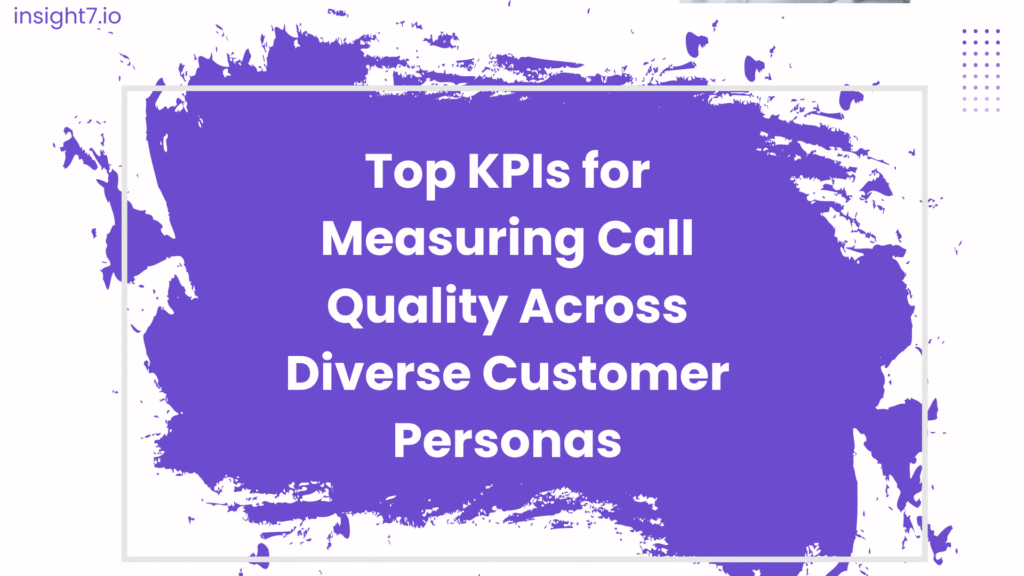Top KPIs for Measuring Call Quality Across Diverse Customer Personas
-
Kehinde Fatosa
- 10 min read

You’ve just wrapped two calls with two very different buyers.
The first was a technical lead at a scaling fintech startup – sharp, impatient, and deeply involved in the product. She wanted answers fast and cut through the fluff.
The second? A senior manager at a large legacy brand. He was cautious, consensus driven, and quietly navigating internal politics to get buy in for a new solution.
Both calls felt successful in the moment. Your reps followed the script, shared key value points, and booked follow ups.
But by month’s end, only one moved forward.
And no one could explain why.
When call quality is judged using a single static scorecard, you lose the nuance that actually affects conversion.
One size scoring can’t measure whether your team made the right kind of impact, especially when buyer personas are so different.
That’s the trap most teams fall into: tracking “call quality” without defining what quality means per persona.
Why a blanket scoring approach fails across diverse personas
Call evaluations are usually built to track internal performance: did the rep do this, say that, cover those points?
But most teams don’t ask the more important question: Did the rep connect the right way for this type of buyer?
For instance, a detail loving researcher will view a call full of sweeping value statements as shallow. A busy exec might see a structured, exploratory call as a time suck.
Each buyer defines value differently. If your KPIs aren’t adjusted to reflect those definitions, your “best” calls may be the least effective.
So how do you measure call quality properly?
Here’s a breakdown of what to track, not just by action, but by impact and persona fit.
1. Persona fit framing
High performing calls adapt to the person in front of you, not just the agenda.
Track whether your team:
- Tailored the language, pace, and priorities to match the buyer’s mindset
- Used examples or frameworks that align with how they think and make decisions
- Addressed known risks early, rather than just pitching features
Your KPI should reflect how well the message landed, not just what was said.
- Decision clarity signals
Good calls create clarity, not just next steps, but next moves people believe in.
Your KPI should assess whether the rep:
- Clarified the customer’s internal decision process
- Identified blockers or hidden stakeholders
- Got a firm, time bound next step
If you’re only tracking whether a next step was discussed, you’re missing the real metric: Did the call reduce decision friction?
- Behavioral response mapping
Forget how the rep performed. Look at how the customer responded.
A high quality call often triggers subtle shifts:
- Increased question depth mid call
- Customer shifting from passive to participatory
- Sharing more context than originally intended
Your KPI here is not sentiment score, it’s engagement progression.
- Narrative alignment
Every customer enters a call with a mental narrative. A good call plugs directly into that story, using their language, reflecting their stakes.
Track whether the rep:
- Paraphrased their problem in their own words
- Mapped your solution to their unique context
- Created a clear, believable before/after arc
If a customer says, “That’s exactly what I’ve been trying to explain internally,” that’s your KPI.
- Cross call consistency
Even with different personas, your team should align internally on how quality is judged.
Evaluate whether:
- Managers score the same call similarly
- Feedback loops are unified
- Everyone understands how persona context affects quality
The KPI here isn’t about the customer.
It’s about internal calibration, and avoiding fragmented evaluation standards.
How to implement this without adding complexity
You don’t need a bespoke scorecard for every persona.
Instead, build a flexible framework:
- Core KPIs: Apply to all calls (e.g., clarity, engagement, trust)
- Persona modifiers: Adjust based on who’s on the other end
- Call calibration routines: Regular team syncs with annotated examples
This lets you measure both delivery and resonance, without drowning in edge cases.
If you’re tracking all of this in spreadsheets, call recording tools, or through scattered manager notes, you’re not only wasting time, you’re losing valuable signals.
Insight7’s platform is built to:
- Automatically identify behavioral and sentiment shifts
- Score calls using flexible, persona-aware criteria
- Align managers around consistent, outcome-driven quality checks
It’s structured enough to scale. Flexible enough to fit different customer realities. Fast enough to keep up with real world teams.
And unlike generic tools, it’s built with nuance in mind, so you’re not just saying “that was a good call,” but understanding why it worked and who it worked for.
Final Thought
Quality isn’t a checkbox. It’s a match between your rep’s approach and your buyer’s mindset.
When you track the right KPIs, you stop optimizing for generic performance, and start enabling context specific impact.
That’s how real growth happens. One calibrated, high quality call at a time.







